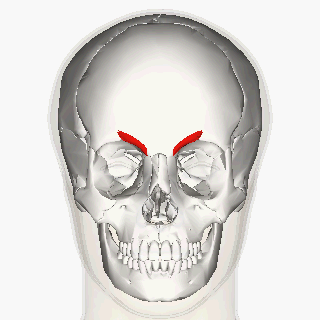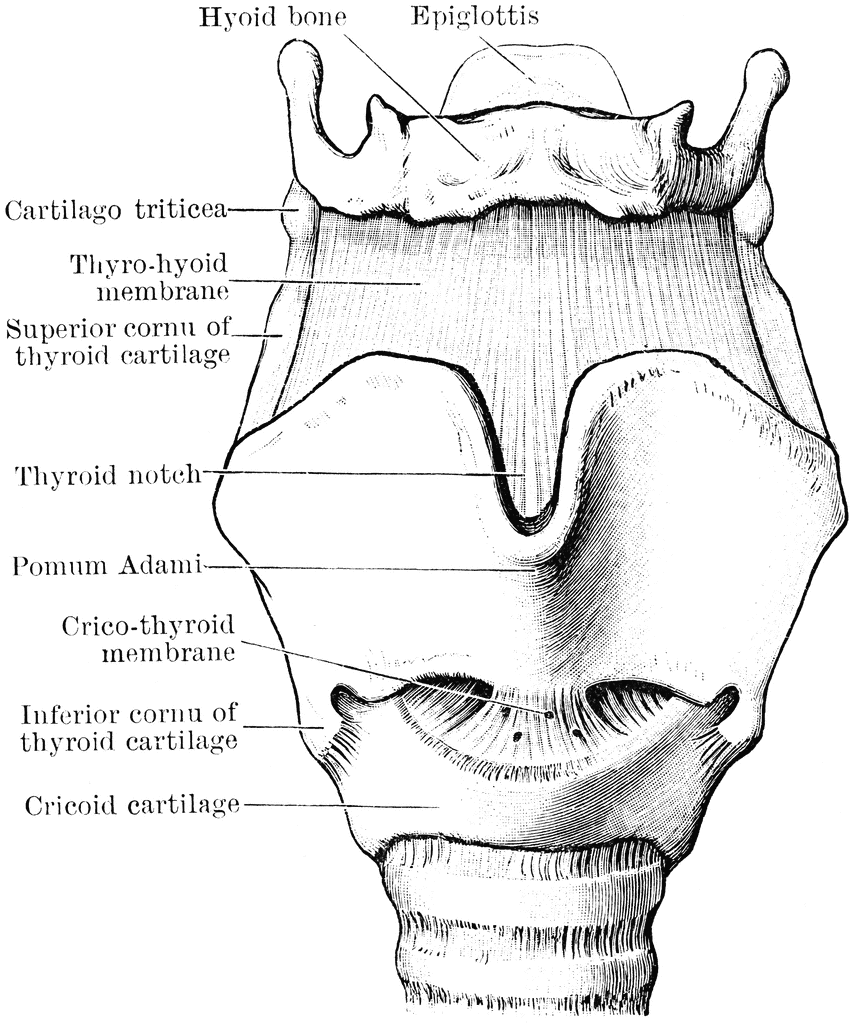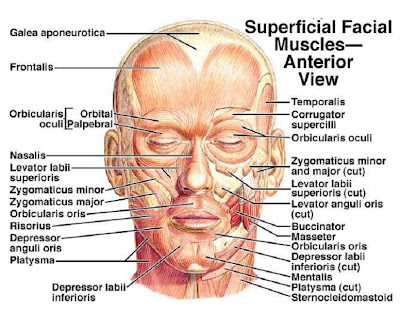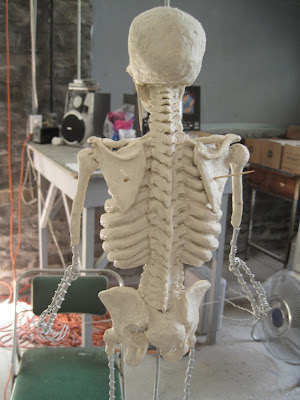The Triceps is most often glossed over in the anatomy texts. What is so often understated is how the long head of the triceps inserts into the body of the lateral and medial head. Three muscle bodies which have striking analogous similarities with the quadriceps of the leg.
Saturday, October 26, 2013
Sunday, August 11, 2013
Thursday, May 16, 2013
Ecorche Brachium
Here's where we are so far with the life sized Ecorche. Presently we're examining the mechanisms inherant in and around the Brachium.... the arm and shoulder apparatus as it attaches to the torso.
Tuesday, May 14, 2013
Sunday, March 31, 2013
Half Skeleton Muscle Demo Prop
I've been using this armature I made from an articulated plastic skeleton to demonstrate muscle origin and insertion. It's a old somso cast I believe, so the detailing is better than a Bucky. After extensive use, it started to fall apart so I tweaked the armature using 3/8" galvanized pipe and a 1/2" conversion coupling to 1/2" nipple and phlange.so now it's ready to go.
This time I'm going to use the kleen klay unsulpherated terra cotta color.... it's more life like.
Friday, March 29, 2013
Comparative Anatomy- The forelimb
Here I have superimposed the actual bone on a demo drawing to illustrate how the radius has evolved/devolved based on survival imperative.I've laid out the human dog, and horse brachia to illustrate this.Most obvious is the lack of clavicles in the dog and horse and the gradual restricted movement of the radius in the dog to total fusion of the ulna with the radius in the horse into permanent pronation.
Monday, March 11, 2013
Friday, March 8, 2013
The Hyoid and deep neck muscles
Before we drape the outer muscles of the neck onto the cervical column , there are a few muscles that the artistic anatomist might like to consider including.on their Ecorche.
These are the muscles that either insert and originate on the Hyoid bone.
The Omohyoid muscle, interestingly enough, can be readily seen on a model with low body fat - a strap like muscle that originates on the Coracoid processof the Scapula and like a fountain travels up the nexk to the Hyoid.
Friday, March 1, 2013
Tuesday, February 19, 2013
Monday, February 18, 2013
Frontalis muscle
The frontalis muscle, also known as the occipitofrontalis or
epicranius, is thin, of a quadrilateral form, and intimately adherent to the
superficial fascia. It is broader than the Occipitalis and its fibers are
longer and paler in color. It is located on the front of the head.
It has no bony attachments.
Its medial fibers are continuous with those of the Procerus; its immediate
fibers blend with the Corrugator and Orbicularis oculi, thus attached to the
skin of the eyebrows; and its lateral fibers are also blended with the latter
muscle over the zygomatic process of the frontal bone.
In the eyebrows, its primary function is to lift them (thus opposing the
orbital portion of the orbicularis), especially when looking up. It also acts
when a view is too distant or dim.
From these attachments the fibers are directed upward, and join the galea
aponeurotica below the coronal suture.
The medial margins of the Frontales are joined together for some distance
above the root of the nose; but between the Occipitales there is a
considerable, though variable, interval, occupied by the galea aponeurotica.
It could be part of occipitofrontalis muscle.

Levator Labii Superioris and Corrugator muscles
Superior to the mouth are the Levator muscles.
Levator Anguli Oris( lying underneath the Levator Labii Superioris)
The Levator Labii Superioris has a medial portion which continues superior toward the corner of the eye.
The medial fiber is known as the Levator Labii Superioris Alaeque nasi muscle.
The levator labii superioris (or quadratus labii superioris) is a muscle of the human body used in facial expression. It is a broad sheet, the origin of which extends from the side of the nose to the zygomatic bone.
Its medial fibers form the angular head, which arises by a pointed extremity from the upper part of the frontal process of the maxilla and passing obliquely downward and lateralward divides into two slips.
One of these is inserted into the greater alar cartilage and skin of the nose; the other is prolonged into the lateral part of the upper lip, blending with the infraorbital head and with the Orbicularis oris.
The intermediate portion or infraorbital head arises from the lower margin of the orbit immediately above the infraorbital foramen, some of its fibers being attached to the maxilla, others to the zygomatic bone.
Its fibers converge, to be inserted into the muscular substance of the upper lip between the angular head and the Caninus.
The lateral fibers, forming the zygomatic head, arise from the malar surface of the zygomatic bone immediately behind the zygomaticomaxillary suture and pass downward and medialward to the upper lip.
The two Zygomaticus,minor and major,extend from the lateral and posterior portion of the Zygomatic bone( far back on the cheek and attach on the oris and lip tissue.
There are two sections of the Obicularis Oris muscle, i.s., the palpebral section (eyelids) and orbital section(sheathing out the socket anteriorly.
Medial and extending from the bridge of the nose lateraly toward either side is the Nasal muscle
Medial and extending from the bridge of the nose lateraly toward either side is the Nasal muscle
Just above the obicularis muscle is a angled fibrous section of muscle that covers the glabellar swelling.
It is known as the Corrugator muscle.
The Corrugator supercilii is a small, narrow, pyramidal muscle, placed at the medial end of the eyebrow, beneath the Frontalis and just above Orbicularis oculi.
It arises from the medial end of the superciliary arch; and its fibers pass upward and laterally, between the palpebral and orbital portions of the Orbicularis oculi, and are inserted into the deep surface of the skin, above the middle of the orbital arch.
It is known as the Corrugator muscle.
The Corrugator supercilii is a small, narrow, pyramidal muscle, placed at the medial end of the eyebrow, beneath the Frontalis and just above Orbicularis oculi.
It arises from the medial end of the superciliary arch; and its fibers pass upward and laterally, between the palpebral and orbital portions of the Orbicularis oculi, and are inserted into the deep surface of the skin, above the middle of the orbital arch.
The Corrugator draws the eyebrow downward and medially,
producing the vertical wrinkles of the forehead. It is the “frowning” muscle,
and may be regarded as the principal muscle in the expression of suffering].
It also contracts in order to prevent high sun glare, pulling the eyebrows
toward the bridge of the nose, making a roof over the area above the middle
corner of the eye and typical forehead furrows.

Saturday, February 16, 2013
Sunday, February 10, 2013
Muscles of the Head
This is a compendium to the Ecorche survey.
In this installment I'll be presenting an overview of the muscles of the skull and their
influences on surface anatomy.function, and expression.
influences on surface anatomy.function, and expression.
Edward Lanteri, in the classic Modeling and Sculpting the Human Figure, divides the muscles of the head into seven groups.Masticatory, Epicranial, Auricular, Ocular, Palpebral, Nasal, and Labial.. Palpebral refers to the palpebral fissure or the "eye opening" which together with the Ocular,Nasal and Labial and with some limited movement being contributed by the frontalis of the epicranial group, compromise the muscles of expression.The Masticatory, or muscles of chewing, include, the Temporal, the Masseter, the Internal Pterygoid, the External Pterygoid, and the Buccinator muscles.For the student of Drawing and Sculpture, the moving muscles of the head can thus be further simplified to the muscles of chewing/nourishment acquisition which are primarily side plane, and the muscles of expression which are primarily front plane.
For further reading a detailed illustrated course text is avaiable here:
Constructing the Skeleton
The first step in modeling the skeleton onto the armature is of course to choose thr right kind of clay substrate for the sculpture. Ecorches are modeled in non drying plastilina to facilitate the evolution of the modeling process and in addition to prevent details from drying and chipping away from the armature as would be a problem using wet clay, although I'm sure Houdon's majestic Ecorche he fabricated was in natural terracotta.After much experimentation and numerous Ecorches, we have chosen the non sulfurated Kleen Klay and for aesthetic reasons have chose to model the skeleton in ivory colored clay and apply the muscles in the terra cotta color.
.
The Armature
The Ecorche armature
Central to the building of the Ecorche as it is to any sculpture is the internal foundation onto which the clay conforsa and acquires its stability. The armature for the Ecorche is designed to be embedded inside the skeleton and to support the delicate framework onto which the muscles are built.After much experimentation, a sturdy and lightweight armature was constructed from galvanized 3/4"pipe nipples, couplings and phlange along with various gauges of aluminum armature wire , threaded steel rod, fittings and hardware.
A sturdy plinth was constructed from 7/8"
Luan ,pine planks underneath to minimize warping and a pine pedestal
through which lock nuts and armature wire could be inserted.
A detailed instructional ebooklet on how to build an ecorche armature is avaiable here:
Subscribe to:
Comments (Atom)

















































